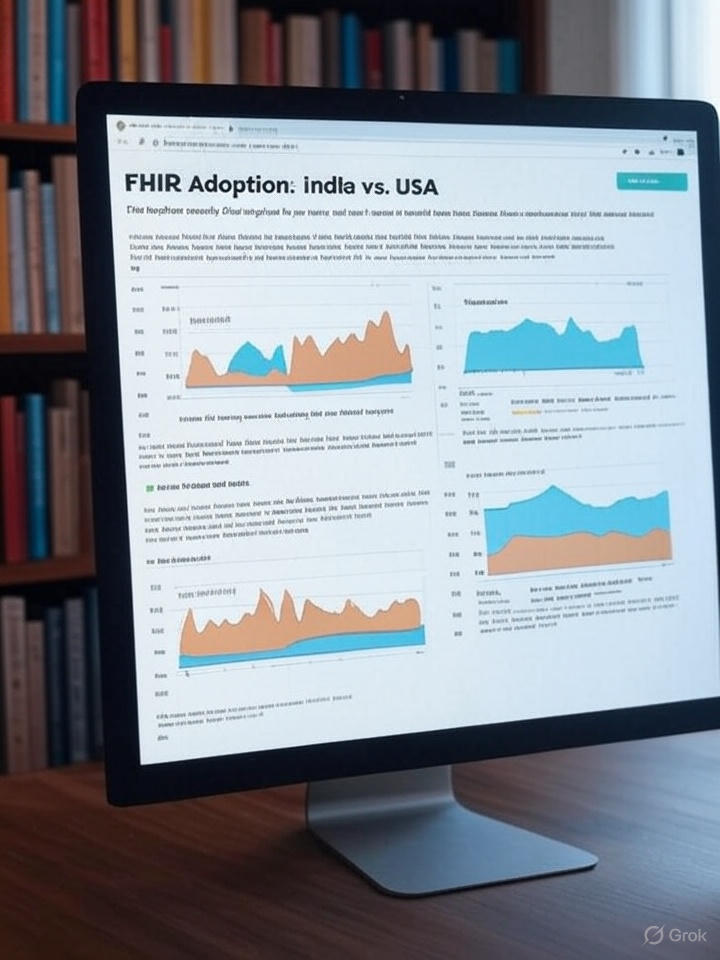Hello! Today, we're diving into FHIR (Fast Healthcare Interoperability Resources), a key standard in the healthcare sector for data exchange. This blog will start with an overview of FHIR, then compare its current status in India and the USA (based on 2025 updated information), and finally discuss how FHIR was designed to store patient health records but remains quite distant from patients themselves. This information draws from web research and survey reports, such as Firely's 2025 FHIR Adoption Survey.
What is FHIR?
FHIR, developed by HL7 (Health Level Seven International), is an open standard designed to make health data exchange seamless. It uses RESTful APIs, JSON/XML formats, and web technologies, making implementation straightforward. FHIR's primary goal is to enable interoperability between electronic health records (EHRs), clinical data, and patient information across different healthcare systems. For instance, a hospital system can share data with another clinic without custom integrations. In 2025, FHIR is gaining rapid global adoption, with 71% of countries reporting active use in at least a few use cases.ab11bb This standard promotes patient-centric health records, but as we'll explore, real-world challenges persist.
FHIR Status in India
In India, FHIR adoption is accelerating, largely driven by government initiatives. The Ayushman Bharat Digital Mission (ABDM) integrates FHIR at its core, with Health Information Exchange (HIE) and Consent Manager being FHIR-based.054f24 By 2025, the government had set a 70% adoption target, and reports indicate significant progress in large health networks.33a590 For example, the Open Health Claims Exchange protocol is FHIR-based and mandated by the government, simplifying insurance claims.131ff9 Under ABDM, patients receive an ABHA (Ayushman Bharat Health Account), which supports data sharing via FHIR. However, adoption is primarily limited to governmental and major hospitals; rural areas face infrastructure and awareness gaps. In the 2025 survey, developing countries like India benefit from policy support (78% of countries have regulations), boosting FHIR.
FHIR Status in the USA
The USA leads globally in FHIR adoption, supported by robust regulatory frameworks. The Office of the National Coordinator for Health Information Technology (ONC) promotes FHIR, and the 21st Century Cures Act mandates API-based data sharing.018e39 In 2025, initiatives like HTI-1 requirements, USCDI v3, and SMART 2.0 keep FHIR central.738065 Nearly 90% of health systems have implemented FHIR-enabled APIs.5d2805 Starting January 2026, payers must use FHIR APIs for electronic prior authorization.b4c197 Tools like Blue Button 2.0 leverage FHIR for patient access. Challenges include data security and vendor compliance. The 2025 global survey notes that countries like the USA have FHIR active in "many use cases.
India vs USA: A Comparison
.Adoption Level: The USA's adoption is more mature, with over 70% of countries (including the USA) showing active use, but India is catching up quickly through programs like ABDM.2b41f0 In the USA, private sectors (e.g., Epic, Cerner) have integrated FHIR, while India's is government-driven (70% target by 2025).
.Regulations: Both have strong policy support—the USA with ONC and Cures Act, India with ABDM and Health Claims Exchange. However, US enforcement is stricter, like the 2026 FHIR API mandate.
.Challenges: India grapples with infrastructure gaps (rural vs. urban), while the USA deals with data privacy and high costs. Globally, 2025 shows FHIR momentum but policy gaps remain.
.Patient Focus: In the USA, patient portals (e.g., MyHealthEData) use FHIR for data access, but India's ABHA is still in early stages. Overall, the USA leads, but India's pace is impressive.
FHIR Was Built for Patient Health Records, But Why Is It Still Far from Patients?
FHIR's core idea is patient-centric—it makes health records portable so patients can easily access and share their data. Yet, in reality, it's "distant" from patients for several reasons:
- Implementation Challenges: While theoretically excellent, real-world use is in early stages. Semantic interoperability (consistent data meaning) is incomplete, and EHR systems limit write access
- Privacy and Security Issues: Increased data sharing raises privacy risks, and tools for patient control (e.g., consent management) are immature. No single data model handles all complex health data.
- Adoption Gaps: FHIR is mostly used between providers and insurers, not for direct patient access. Patients need technical knowledge, and awareness is low. For example, even in the USA, patient data access regulations exist, but delays and complexity persist.
- Global Perspective: 2025 surveys show FHIR momentum, but more work is needed for patient engagement. In countries like India, the digital divide exacerbates this distance.
Conclusion
FHIR is transforming healthcare, especially in India and the USA, where adoption rates are high. India is advancing through government push, while the USA leads with regulatory strength. However, to truly center patients, we need better implementation, awareness, and security. If you're interested in developing FHIR apps or more details, comment below! Do you think FHIR will reach patients soon?
FHIR: The Future of Healthcare Data Interoperability, But Still Far from Patients






